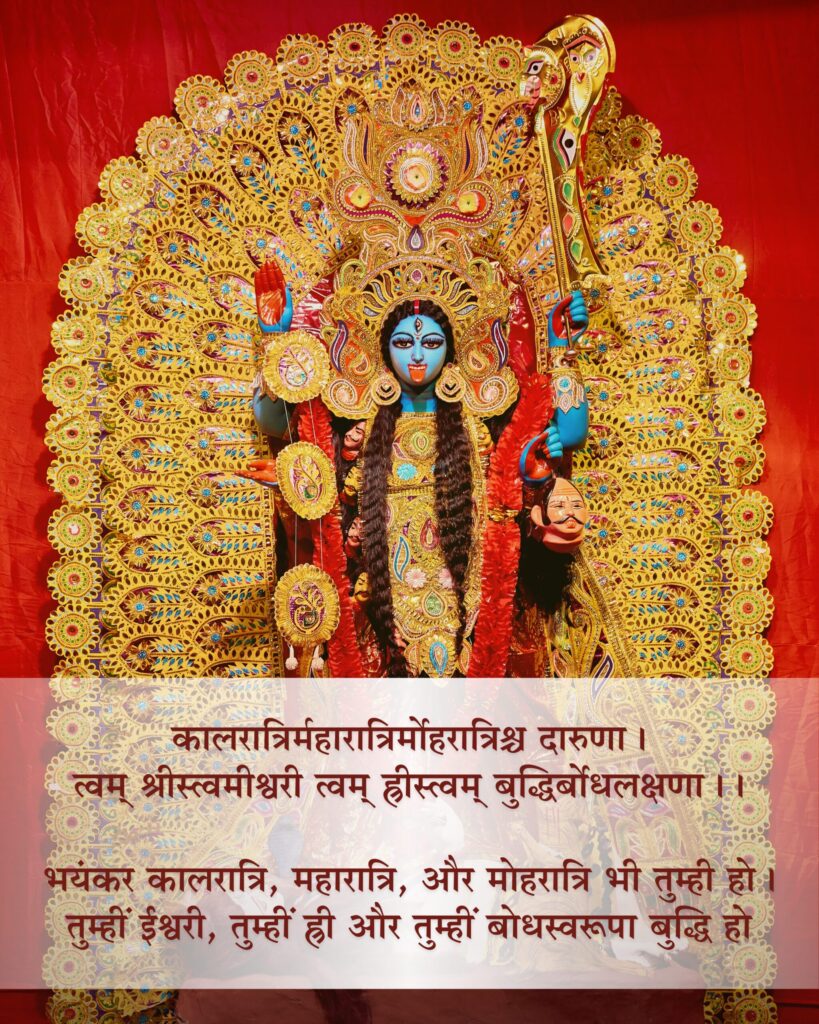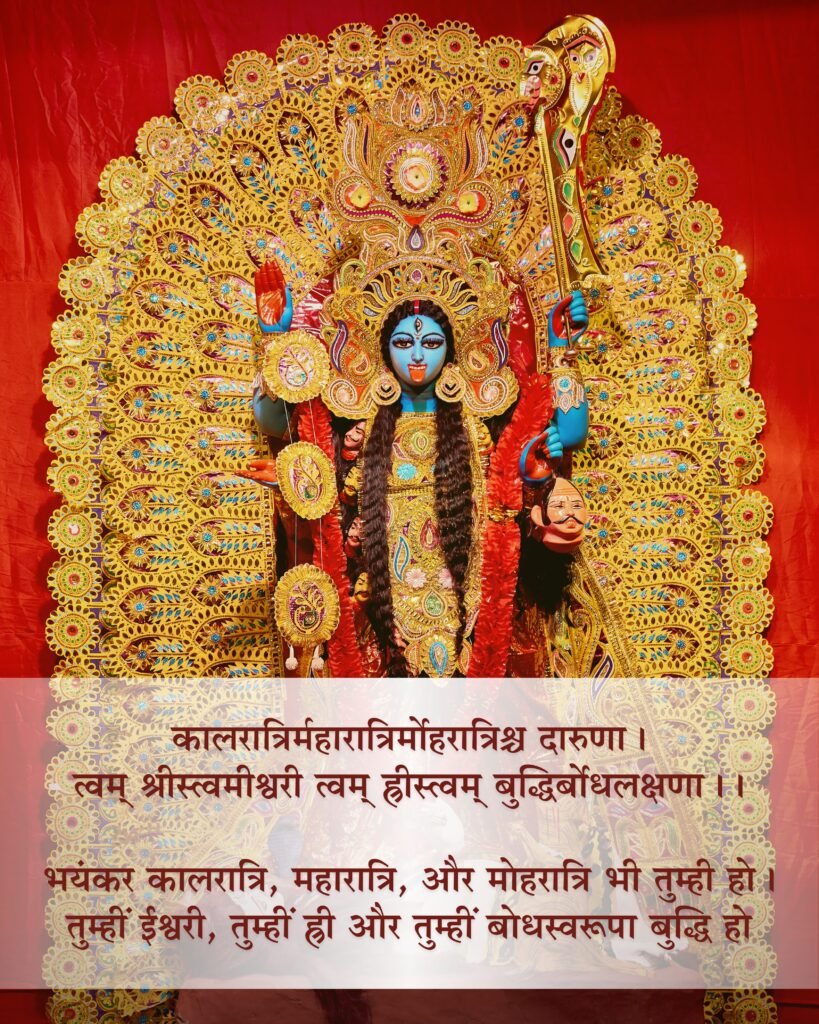
The Significance Of Four “Divine Nights”
June 26, 2024
The Significance Of Four “Divine Nights”

कालरात्रिर्महारात्रिर्मोहरात्रिश्च दारुणा।त्वम् श्रीस्त्वमीश्वरी त्वम् ह्रीस्त्वम् बुद्धिर्बोधलक्षणा।।
भयंकर कालरात्रि, महारात्रि, और मोहरात्रि भी तुम्ही हो।तुम्हीं ईश्वरी, तुम्हीं ह्री और तुम्हीं बोधस्वरूपा बुद्धि हो
- कालरात्रि (दीपावली)
- महारात्रि (शिवरात्रि)
- मोह रात्रि(जन्माष्टमी)
- दारूण रात्रि (होली की रात)
Hindi Translation:
काल की रात्रि महान रात्रि है और मोह की रात्रि भयानक होती है, तू भाग्य की देवी है, तू लज्जा है, तू बुद्धि है, समझ की निशानी है।
आप भयानक कालरात्रि, महारात्रि और मोहरात्रि भी हैं। आप दिव्य हैं, आप ह्रीं हैं और आप आत्मज्ञान की बुद्धि हैं।
————————————————————
Astrology is referred to as a divine science, which depends upon constellations, sun signs and the position of the plants. It has the power to predict fortune and bring out a larger picture into perspective. Similarly, as per yotish Vidya, there is a predominant connection between spirituality and specific festivities that are also known as the “Divine Nights.” Among these few yoga’s/auspicious phases there are 4 divine nights, which are considered highly auspicious and powerful, which encapsulates itself in these major festivals namely Shivratri, Janmasthami, Holi and Deepawali. These 4 nights are called Maha Ratri’s.
The relevance of Cosmic Day/Night with a Divine Night
Understand this with a simple phenomenon of nature, where, as soon as the day reaches its end, it leads to the appearance of the night. In this circumstance, all the creations emerge in infinite diversity from the unmanifested state. This naturally unifies back into the oneness of the unmanifest. Similarly, the cosmic day dawns along with its creation and stays for 1000’s of ages before the oneness re-manifests, as unrelated forms again at the dawn of another cosmic day. Beyond these manifested and unmanifested states of phenomenal existence, there lies a true unmanifested reality. That exists eternally and rests untouched by these cycles of creation and dissolution. Experiencing this infinite and enduring state is referred to as the “unmanifested state of reality”, which is the eventual objective of life.
Those who accomplish this highest state never come back to a normal life existent in this world.
What does a Divine Night refer to?
It is observed that most people are not aware of these 4 divine nights, which are considered very powerful after the sun sets down. Where the universe, sky and atmosphere release very strong cosmic kinetic energies that fall on the earth. These cosmic kinetic energies are paramount for those people who practise any spiritual prayers/sadhana. These energies prevail and remain on the earth till the next sunrise. And as soon as the sun rises the night morning, these energies return to the sky and slowly start to disappear.
You’ll be enthralled to know that the effect of these prayers is 500 times more powerful in comparison to what a person offers in his/her daily prayers. So, spiritual seekers aka sadhaka follow a practice of chanting mantras/observe prayers when they have a peaceful environment around (as it is considered the best time for spiritual practices) while shutting themselves from the hustle and bustle of the entire day (Ideally I choose the time between 11:00 pm. to 1:00 a.m.). In order to make it successful/sidha or even charge themselves in ways more than one.
Read on to know more about each of these divine nights in detail
Shivratri (The night of Lord Shiva): Celebration of Lord Shiva’s marriage
As per Indian astrology, there are certain days and phases in a year that are favourable for spiritual growth, leading to a smooth meditation practice, where Mahashivratri is one such day. This sacred day falls on the 13th or 14th night of the new moon during the Krishna Paksha in the lunar month of Phalgun. According to the Sanskrit term, Krishna Paksha refers to the period of the waning moon/the dark fortnight. Whereas Phalgun corresponds to the month of February/March as per the English calendar. This festival is celebrated on a moonless night, where the planetary positions in the Northern hemisphere act as a potential catalyst to support an individual in raising his/her spiritual energy more effortlessly.
On the auspicious night of Shivratri, the devotees stay awake and observe prayers/puja. And some even chant Vedic mantras where Rudram holds great importance while practising sadhana/meditation. Along with it, the devotees offer belpatra to Lord Shiva which comprises of 3 aspects of one’s nature i.e. Tamas, Rajas and Sattva, resonating a sense of freedom. It is believed that the kinetic cosmic energies boost the potential of any sort of chanting/japa, meditation/dhyan or any powerful practice offered as worship to Lord Shiva or his shakti. Hence, the meditation performed on this day is 100 times more effective and gives away a sense of peace and benevolence within the devotee. Not just this but it also eradicates negative elements associated with the mind i.e. desire, anger, greed, attachment, ego and jealousy.
Janmashtami: Celebration of Lord Krishna’s birth:-
This day when Lord Krishna descended on the earth, it was a sign that he is committed towards our freedom. Hence, at every Janmashtami, it is a gentle reminder for mankind to immerse oneself in spirituality so as to attain freedom from the materialistic world/maya. Where a devotee can chant the Hare Krishna maha-mantra to manifest Lord Krishna’s presence and blessings.
Holi/Holika: Triumph of good over the evil:-
This festival is observed as the New year according to the Hindu calendar, which is celebrated with joy and vigour amidst the riot of colours. This festival roots back to the story of Prahlad who was the son of king Hiranya Kashyap. Prahlad never followed the words and footsteps of his father, instead was a passionate devotee of Lord Vishnu. The father couldn’t stand Prahlad’s behaviour and put him in dangerous acts, in order to punish/hurt him. However, all his endeavours went in vain. Prahlad emerged out unhurt and protected from all these hurtful series of events. His father’s last and most fatal attempt was to burn him alive along with his sister Holika (she couldn’t burn in fire).
However, while Prahlad sat on her lap, Holika got burnt and turned into ashes yet Prahlad came out victorious/alive. In the end, Hiranya Kasyapu was destroyed by Narasimha while proving through this story that the devotee (Prahlad) never lost his faith in the Lord despite all odds. Taking this discussion further ahead, some people have a misconception that Holika Dehan is the auspicious day, however, on this day most fake priest/pandit (Lal Kitab pandit) observe black magic/tona totka. Hence, people should indulge in spiritual practices on the main day of Holi (when the colours are being played).
Deepawali: A symbol of divinity, knowledge and purity;-
This festival takes places either in October/November and falls on the 15th day of the Hindu month of Kartik (which varies every year). Generally, there are 4 static/sthir lagnas to pray on these days out of which the two most powerful lagna (timing of doing prayers on these 4 days) are in the time of Vrushabh lagna (Taurus) and Sing lagna (Leo). This can be referred to on those dates through panchang. As per the traditions and customs, it is believed that waking up during the Brahmamuhurta (at 4 a.m. or 1 1/2 hours before sunrise) is the best time to attain blessings from health, discipline, work efficiency, and spiritual growth point of view.
The wise men/sages who established this custom invested their hopes in their descendants, that they will realize its advantages and inculcate it as a regular habit for a lifetime.
Festival per se, it is celebrated to mark the return of Lord Rama from Ayodhya (after defeating Ravana). Where the festival is celebrated to rejoice the victory of good over evil. For this, people start cleaning every nook and corner of their homes many days prior to the festival. While on the festive day, they lit diya’s (signify a time of inner illumination), put on lights, burn incense sticks, offer prayers to goddess Laxmi along with Prashad (it includes makhane, singhade, nariyal, patashe, paan, etc.) And post puja burn firecrackers to make the most of this festival.
The purpose of this informative blog was to enlighten you about the divine nights, which are also known as Maha Ratris. As there are several spiritual occasions/auspicious timings, which people are unfamiliar with. However, once you invest your faith and time in observing the spiritual consciousness on these magical comic nights, you’ll be able to attain eternal bliss, peace, and freedom from the worldly pleasure/maya.
